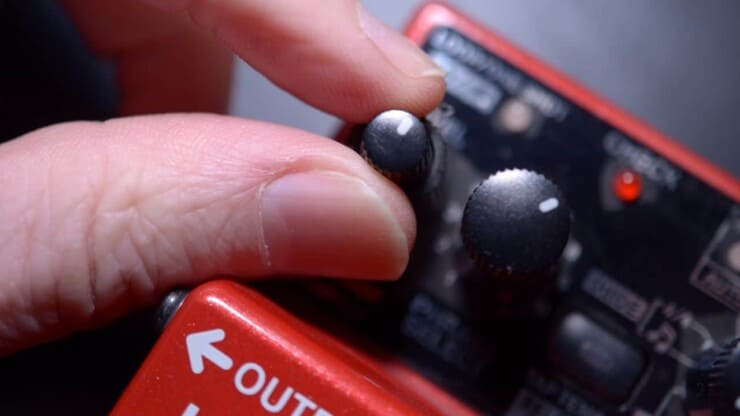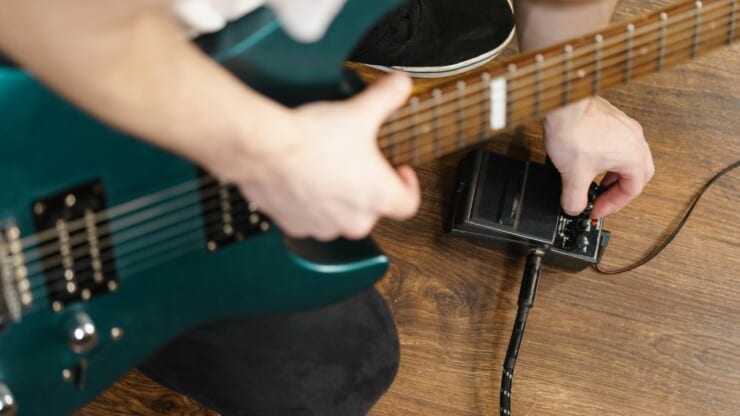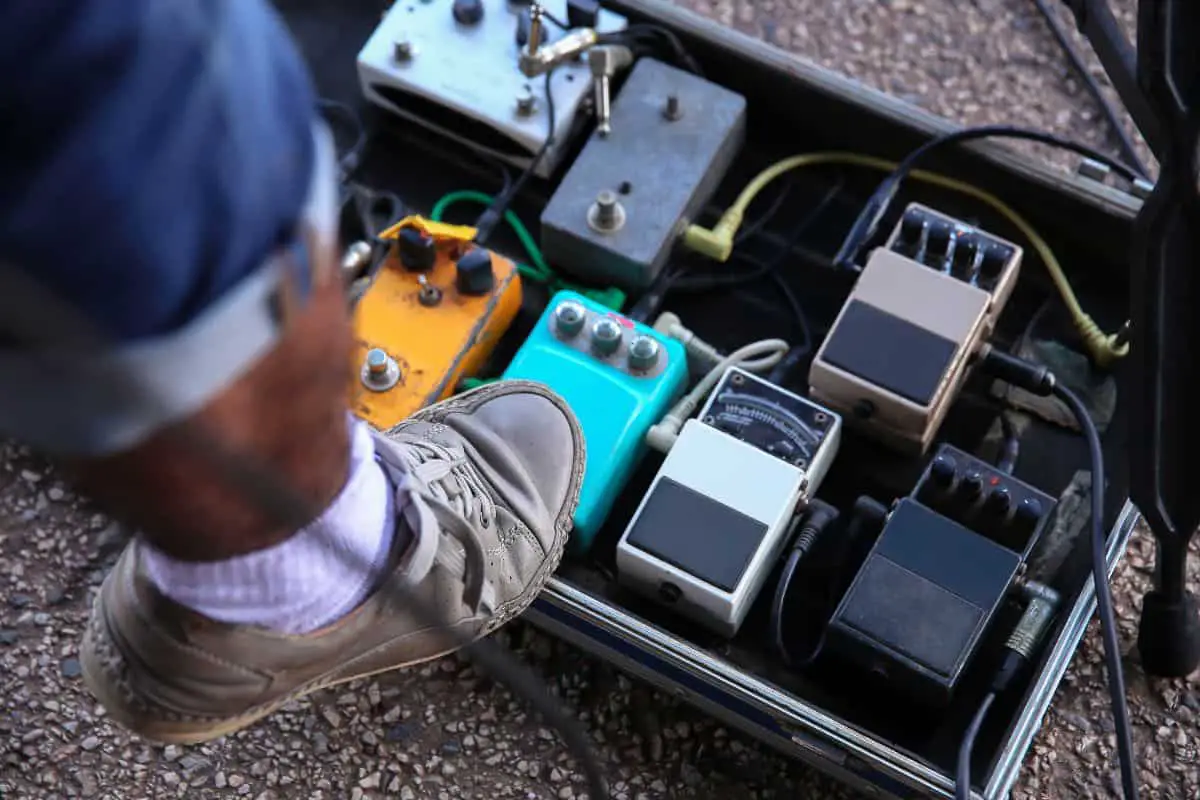Are you a beginner guitarist looking to add some new gear to your setup? If so, then one of the first questions you’re likely asking yourself is “what guitar pedal should I get first?” With all the different types of pedals available on the market, it can be hard for beginners to know where to start.
Luckily, we are here with helpful information about what types of pedals will benefit your playing and which ones are best suited for beginner players. We’ll cover topics such as types of guitar pedals, the benefits they offer, and what factors you need to consider when buying one. Finally, we’ll provide our top picks for the most important guitar effects that any aspiring musician needs in their arsenal!
Types of Guitar Pedals
Distortion Pedals: Distortion pedals are one of the most popular types of guitar effects. They create a distorted sound by adding extra gain and clipping the signal. This can be used to create heavy, crunchy sounds or even more subtle overdrive tones. Distortion pedals come in many different shapes and sizes, from classic stompboxes to multi-effects units with multiple distortion settings.
Delay Pedals: Delay pedals are another type of effect pedal that adds an echo-like effect to your guitar’s sound. These effects range from short slapback delays to long reverb-like echoes that can last for several seconds. Delay pedals also come in various forms, including analog and digital versions, as well as those with tap tempo features for easy synchronization with other instruments or backing tracks.
Reverb pedals are an essential part of any guitarist’s tone palette, providing depth and atmosphere to their playing. These devices allow the user to add natural sounding reverberation without having to use a separate amp or rack unit dedicated solely for this purpose. There is a wide range of reverb available on these pedals, from spring reverbs found on vintage amps all the way up to modern convolution reverbs which accurately emulate real acoustic spaces such as churches or concert halls.
Ready to take your guitar playing to the next level? Get yourself a distortion, delay or reverb pedal and start shredding like never before! #GuitarPedals #ShredOn #AllStringed
Benefits of Using Guitar Pedals
Using guitar pedals can be a great way to take your playing to the next level. They offer a wide range of sounds and effects that you wouldn’t otherwise have access to, allowing you to create unique tones and textures for your music. Here are some of the benefits of using guitar pedals:
- Create Unique Sounds: Guitar pedals give you the ability to craft new sounds that weren’t possible before. With distortion, delay, reverb, chorus, and other types of effects at your disposal, it’s easy to find something that fits perfectly with whatever song or style you’re trying to create. Experimenting with different combinations can help bring out hidden nuances in your playing or open up entirely new sonic possibilities.
- Expand Your Tone Palette: With so many options available in today’s market, there is no shortage of ways to expand your tone palette when using guitar pedals. Whether it’s adding subtle overdrive for warmth or experimenting with wilder modulation effects like flanger and phaser for texture – having access to these tools allows players an unprecedented amount of control over their soundscape.
- Guitar pedals, when used correctly, can add a great deal of depth and dynamics to both live performances and studio recordings. Compression ensures that all notes are heard clearly, while delays provide an interesting backdrop behind solos or riffs without detracting from the main focus; this is essential for performing in front of an audience.
Guitar pedals can be a great way to take your playing to the next level by allowing you to craft unique sounds and expand your tone palette. With distortion, delay, reverb, chorus, and other types of effects at your disposal, it’s easy to find something that fits perfectly with whatever song or style you’re trying to create. Additionally, guitar pedals can add depth and dynamics in both live performances and studio recordings.
What to Consider When Buying a Guitar Pedal
When it comes to buying a guitar pedal, there are several things you should consider. Price range and budgeting is an important factor when selecting the right pedal for your needs. It’s important to research different models before making a purchase in order to find one that fits within your budget while still providing quality sound.
Quality and durability are also essential factors when choosing a guitar pedal; look for pedals with sturdy construction and reliable components, so they can withstand regular use without breaking down or needing repairs.

Versatility and compatibility with other gear is another key consideration when purchasing a guitar pedal. Look for pedals that offer multiple effects, such as distortion, delay, reverb, chorus, etc., so you can create unique sounds depending on what type of music you play. Additionally, make sure the pedal will work well with other pieces of equipment in your setup, like amplifiers or mixers – this will ensure smooth operation during performances or recording sessions.
Finally, be sure to read guitar pedal reviews from other users who have purchased the same model before making a decision; this will give you insight into how well it works in various settings and if there are any potential issues that could arise after using it regularly over time. By taking all these factors into account when shopping for guitar pedals, you can find one that meets both your needs and budget while ensuring top-notch performance every time.
Ready to rock? Don’t forget to consider price, quality, durability, and compatibility when shopping for a guitar pedal – it’s the key to getting the best sound out of your setup! #GuitarPedalShopping #AllStringed
Best Guitar Pedals for Beginners
When it comes to getting started with guitar pedals, there are a few models that stand out as great choices for beginners. The Ibanez Tube Screamer TS9/TS808 is an overdrive/boost pedal that can help you achieve the classic rock and blues tones of your favorite guitarists. This pedal has been used by some of the greatest players in history, including Stevie Ray Vaughan and Eric Clapton. It’s easy to use and offers a wide range of sounds from subtle crunch to full-on distortion.
The MXR Dyna Comp compressor is another great choice for novice players looking to add more dynamic control over their sound. This pedal helps even out volume levels while adding sustain and clarity to your tone. It’s also very affordable compared to other compressor pedals on the market, making it an ideal option for those just starting out with effects pedals.
Finally, the Boss CH-1 Super Chorus is one of the most popular chorus pedals around due to its warm analog sound and simple design. Chorus adds depth and texture to your playing by creating two slightly detuned copies of your signal which blend together when you play chords or single notes alike – perfect for producing lush sounds like those heard on 80s pop records!
These three pedals offer something unique yet essential for any beginner guitarist’s rig: versatility. Whether you want clean tones or distorted ones, smooth lead lines or shimmering choruses, all these effects can be achieved with these basic but powerful tools at hand – so don’t hesitate if you’re thinking about taking up guitar pedaling.
For beginner guitarists, there are three essential pedals that can help you get started: the Ibanez Tube Screamer TS9TS808 (overdrive/boost), MXR Dyna Comp compressor, and Boss CH-1 Super Chorus. These pedals offer a range of sounds from subtle crunch to full-on distortion, dynamic control over volume levels with added sustain and clarity, as well as depth and texture with chorus effects. With these basic yet powerful tools at hand, you’ll be able to create smooth lead lines or shimmering choruses – perfect for producing lush sounds like those heard on 80s pop records!
How to Use Guitar Pedals Effectively?
Guitar pedals are a great way to expand your sound and create unique tones. With the right combination of effects, you can take your playing to the next level. But how do you use them effectively? Here are some tips on getting the most out of your pedalboard setup.
Start with the Basics: Volume, Tone, Gain
Before adding any other effects to your chain, it’s important to get comfortable with adjusting volume, tone and gain settings on each pedal. This will help you understand how different combinations of effects interact with one another and allow you to dial in specific sounds more easily. Start by experimenting with just these three basic parameters before moving on to more complex combinations of effects.

Experiment with Different Combinations of Effects
Once you’ve got a handle on adjusting volume, tone and gain levels for each effect individually, start experimenting with different combinations of effects in order to find new sounds that work best for your style or genre of music. Try combining distortion pedals with delay or reverb for a heavier sound; combine chorus and flanger pedals for an ethereal texture; or mix up modulation-based effects like phasers and tremolos for something completely unique!
Learn How To Adjust The Settings On Each Effect
Take some time to learn what each knob on your guitar pedal does, as this will give you greater control over shaping individual tones and creating interesting textures when layering multiple pedals together in one patch. This will also allow for quick adjustments while playing live or recording in studio sessions.
Guitar pedals are a great way to expand your sound and create unique tones. To get the most out of your pedalboard setup, it’s important to understand how different combinations of effects interact with one another. Start by experimenting with just volume, tone, and gain settings before moving on to more complex combinations. Take some time to learn what each knob on your guitar pedal does for greater control over shaping individual tones when layering multiple pedals together in one patch.
FAQs in Relation to What Guitar Pedal Should I Get First
What guitar pedals should I get as a beginner?
As a beginner, it is important to start with the basics when selecting guitar pedals. A good starting point would be an overdrive pedal for adding grit and distortion to your sound, as well as a delay or reverb pedal for creating space in your mix. Additionally, you may want to consider investing in a compressor pedal, which will help even out dynamics and add sustain. Finally, if you are looking for more experimental sounds, look into getting a multi-effects unit that can provide access to many different types of effects at once. With these essential pedals on hand, you’ll have plenty of options for crafting unique tones!
What 5 pedals should every guitarist have?
1. Overdrive Pedal: An overdrive pedal is essential for creating a wide range of classic guitar tones, from bluesy crunch to hard rock distortion. It’s great for adding some extra drive and grit to your sound.
2. Delay Pedal: A delay pedal adds depth and texture to your playing by repeating the notes you play with a slight delay in time. This can be used to create atmospheric sounds or add an interesting rhythmic element to your playing.
3. Compressor Pedal: A compressor pedal helps even out the dynamics of your playing by boosting quieter notes and reducing louder ones, resulting in a more consistent overall tone that cuts through the mix better than without one.
4. Wah Pedal:
The wah-wah effect is iconic in many genres of music, from funk and soul to metal and beyond – it’s just as useful today as it was 50 years ago! With its distinctive sound, this pedal can help you stand out from the crowd when soloing or add an extra layer of expression when riffing away on rhythm parts too!
5. Reverb Pedal: Reverb pedals are great for adding space and atmosphere to any guitar part – they’re especially good at making clean sounds bigger sounding without getting muddy or overwhelming other instruments in the mix like distortion can do sometimes!
What first effect pedal should a beginner buy?
A great first effect pedal for a beginner guitarist is an overdrive or distortion pedal. Overdrive pedals create a warm, bluesy sound, while distortion pedals provide more of a hard rock edge. Both types of effects are versatile and can be used to achieve many different sounds. It’s important to consider the type of music you want to play when selecting your first pedal, as some may be better suited for certain genres than others. Ultimately, it comes down to personal preference, so don’t hesitate to experiment with different models until you find one that works best for you!
What should the order of guitar pedals be?
The order of guitar pedals depends on the type of sound you are trying to achieve. Generally, it is best to start with modulation effects such as chorus, flanger and phaser before moving onto distortion or overdrive pedals. After that, delay and reverb should be placed last in the chain for a more natural sounding effect. Experimentation is key when deciding what works best for your setup – try different combinations until you find something that suits your playing style!
Conclusion
In conclusion, when it comes to deciding which guitar pedal you should get first, there are a few things to consider. First, think about the type of sound you want to achieve and what kind of effects will help you reach that goal. Second, look at the different types of pedals available and decide which ones best suit your needs as a beginner guitarist.
Finally, make sure to use your pedals effectively by experimenting with different settings and combinations for maximum effect! With these tips in mind, we hope you can find the perfect guitar pedal for your setup so that you can start creating amazing music right away! Are you looking for the perfect guitar pedal to take your playing to the next level? Look no further than AllStringed!
Our helpful information and guides will provide insight into which pedals are best suited for beginners. We have a wide selection of affordable yet high-quality gear, so you can find exactly what fits your needs without breaking the bank. Whether it’s an overdrive or fuzz pedal that interests you, our experienced team is here to help guide you in making an informed decision. Don’t wait any longer – start exploring today with AllStringed!



